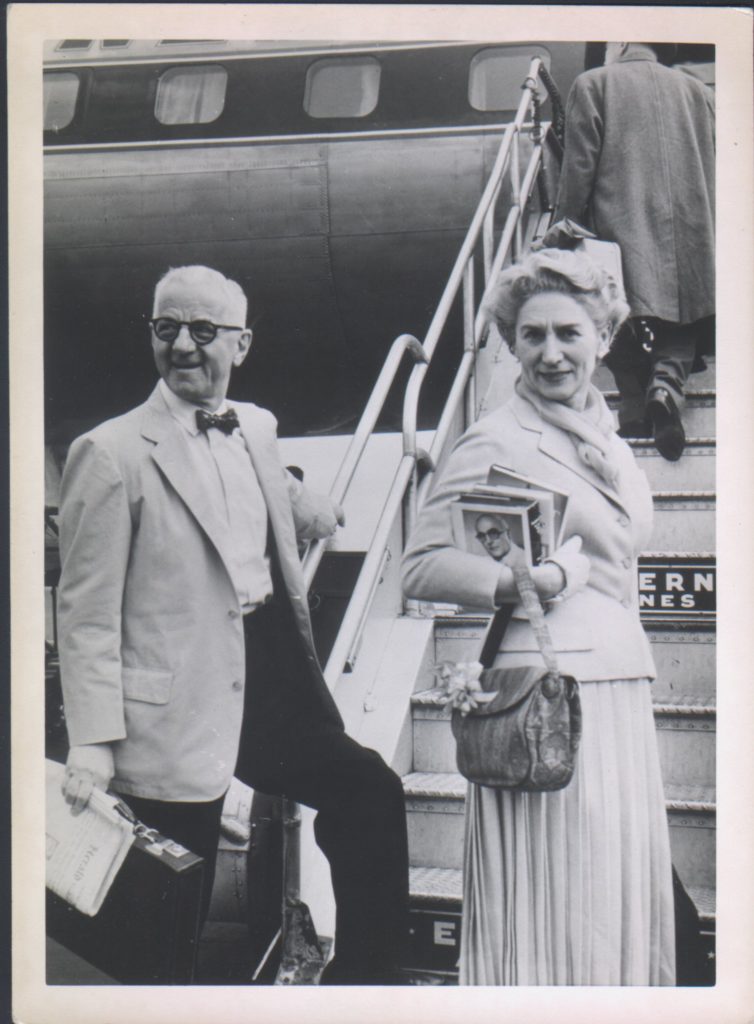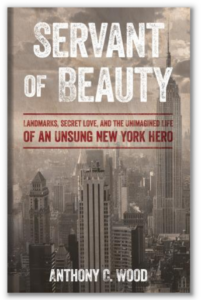IT’S A HELLUVA FUND
Archives Help Reveal The J.M. Kaplan Fund, a Force in Preservation
July 12, 2021
By Elizabeth Rohn Jeffe, Vice-Chair

The recent publication of It’s a Helluva Town: Joan K. Davidson, the J.M. Kaplan Fund, and the Fight for a Better New York has garnered considerable attention in preservation circles, and rightly so. Written by Roberta Brandes Gratz, the book recounts the history of The J.M. Kaplan Fund (the Fund), focusing chiefly on the spirited and critical preservation, environmental, and cultural initiatives of Joan K. Davidson, who served as president of the Fund from 1977 to 1993.
Following in the footsteps of her father, Jacob M. Kaplan, the founder of the Fund, Joan acted as a catalyst to mobilize other groups to mount a variety of initiatives during her memorable tenure at the helm. Just a few of the most notable of Joan’s battles include the creation of Westbeth Artists Housing—an adaptive reuse of a 13-building complex in the far West Village that had once housed Bell Telephone Laboratories—in the 1960s, and the successful fight to block the Westway project in the 1970s. Joan’s numerous battles to save important historical structures are especially instructive for preservationists, such as her fight to preserve Broadway theaters in the 1970s and early 1980s as well as her support of the rescue and restoration of the Eldridge Street Synagogue on the Lower East Side, also in the 1980s.
From the perspective of the Archive Project, It’s a Helluva Town leads quite naturally to the story of the Fund’s archives. How were the materials saved and organized? What can be found in the collections? How are the materials accessible? Who uses the Fund archives, and for what purposes?
Fortunately for posterity, the Fund decided a decade ago to make its archives a priority. Previously, as is so often the case with organizations, a fairly relaxed attitude toward archival materials prevailed at the Fund—as Executive Director Amy Freitag observed in a recent conversation, things were disposed of during moves, or often not saved in the first place. According to Bill Falahee, Director of Finance and Administration and a Fund veteran of 25 years, the decision to organize and modernize the archives, contained in boxes and file cabinets, found its inspiration at a time when action had to be taken to address a lack of space for archival items. When the Fund was still at 261 Madison Avenue prior to locating to 71 West 23rd Street, staff members realized that they were running out of room for grant files in the office itself. (Ten years of grant files were kept in the office; those predating that time period and other materials were kept in offsite storage.)
The moment of decision was at hand: either the Fund would keep putting paper records in storage, or they would have to digitize them. Opting for the latter route, the Fund began the long process of digitizing all the grant files, which were indexed on 3×5 cards with typed information. Known at the Fund as the “Bible cards,” and dating from 1944 to the 1960s, they, along with other files, filled over 300 boxes. To illustrate what the situation with these materials was really like, Bill jokingly noted that when he requested them from storage for research purposes, he needed a hazmat suit because of the dust.
As part of a team effort involving Amy, and Executive Assistants Jack Carlile, Lexi Marek, and Liz Meshel, with the full support of current Fund chair Peter Davidson, a son of Joan’s, Bill approached the task of organizing the archives with the objective of creating a system that would be of use internally and externally. All grants are digitized and arranged by subject. Supplementing the grant information, the archives include texts from speaking engagements, papers relating to designees, photographs, and copies of the many publications that the Fund published over the years. In addition to Fund employees, grantees can now easily search the archives, as can researchers, organizations, writers, academics, and activists. While there is no direct online digital link to the archives, anyone can simply contact the Fund for assistance, and the relevant digital material will be sent. Interestingly, Bill has noticed that most of the contacts for archival information come as a result of someone seeing a mention of a Fund grant while studying something else, such as the battle over Westway.
After the digitization of the grants was completed, the Fund disposed of some unnecessary papers but kept photos and important articles. To protect the privacy of grantees, the Fund hired Shredit to shred any grantee-submitted financial statements; the company processed over three tons of material. Today, remaining offsite materials are saved at an Iron Mountain storage unit.
Going forward, the Fund has promoted a strong sense of saving for its archives within the organization. Although there is no Fund archivist per se, everyone on staff is aware of the protocols of saving. For events, everything in the “run of the show” is automatically kept for the archives; these materials include speeches, pictures, programs, etc., and they are all saved in the Cloud using Microsoft 365. The Fund also continues to educate programming teams to ensure awareness of the necessity of uploading these materials for safekeeping.
Fortuitously, the Fund’s focus on the rebirth of its archives dovetailed beautifully with Roberta Brandes Gratz’s desire to tell the story “of Joan’s legacy and her impact, especially on some of the most vexing and controversial issues of recent decades.” There “needed to be a book” in Roberta’s view, and she was committed to writing it. She independently approached the Fund, received funding, and set about writing It’s A Helluva Town, not “for hire” but as an objective journalist. The timing was perfect: according to Bill, as the archival materials were being digitized, “we began to think about Joan’s story, which was a thread throughout so much of the material. The thought behind it as we went along was, ‘what’s in Joan’s head that is not written down in the files?’”
Additionally, Amy observed that through the lens of Joan’s work, “the focus of Roberta’s book is really on grant-making as it stands for itself—not just about the Fund.” Roberta mentioned in a recent interview that while she did use the archives to check on projects while writing the book, she identifies as a journalist, and she likes to base her writing primarily on her own interviews. Coming full circle, Roberta’s extensive interviews for It’s A Helluva Town were added to the archives, enriching its contents considerably. Amy also noted that Joan and Roberta were “well-matched” as subject and journalist: “neither one was afraid to express an opinion, and they respected each other.” To round out the picture of grant-making found in the Fund’s story, Roberta also suggests studying the history of the now “spent down” Astor Foundation (the archives of which are housed at the New York Public Library) because the two entities partnered on a number of projects.
With the archives now organized, accessible, and protected for the future, the team at the Fund involved in this endeavor is very pleased. As Bill put it, “the archival process has taken time, but being able to access files for grantees and researchers has become a streamlined process. And, because the Fund is an environmental giver, we are happy that we are now a saver as well through decreased paper use.”
From the vantage point of the Archive Project, the Kaplan Fund’s emphasis on protecting its archives and enhancing their accessibility to the public is an inspiration for preservationists. The initiatives at the Fund in the last decade speak directly to NYPAP’s mission to save the stories of individuals active in preservation, such as Joan Davidson; the narratives of preservation battles, won and lost; the history of key grants; and photographs and Fund-generated publications that enhance our understanding of preservation history in New York City.




